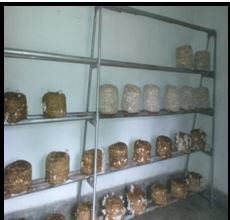Jharkhand State Watershed Mission – Mushroom Cultivation

Watershed Mission is the process of creating and implementing plans, programs, and projects to sustain and enhance watershed functions that affect the plant, animal, and human communities within a watershed boundary. Features of a watershed that agencies seek to manage include water supply, water quality, drainage, storm water runoff, water rights, and the overall planning and utilization of watersheds. Landowners, land use agencies, storm water management experts, environmental specialists, water use purveyors and communities all play an integral part in the management of a watershed.
Jharkhand is the land of trees, herbs, shrubs and varieties of bio-diversity with undulated topography and different land use pattern. Jharkhand is the ideal state to be taken up under Watershed Development Programme. Therefore, the Government of Jharkhand under the Rural Development Department has registered a State Level Nodal Agency as Jharkhand State Watershed Mission (JSWM) on 17/07/2009 under Society Registration Act 21, 1860 for implementation of Integrated Watershed Management Programme (IWMP) under Common Guidelines for Watershed Development Projects, Govt. of India 2008. The Government of Jharkhand has taken initiative under the new guidelines for implementation of watershed projects in the state.
VARIYALI MICRO WATERSHED

Mushrooms can play an important role in contributing to the livelihoods of rural & peri-urban dwellers, through food security & income generation. Mushroom cultivation can represent a valuable small–scale enterprise option.

Smt. Usha Devi a farmer few years back but extremely talented & skilled lady was living her life as usual. Joining a Self Help Group proved to be a boon for her. Watershed team took up a demonstration programme on Oyster mushroom cultivation and production unit. As mushroom cultivation doesn’t require access to land the Self Help Group exhibited a lot of interest during the trainings. A cheque of 6,000INR was presented to the Adivasi Mahila Vikas Samiti (Self Help Group). This amount was invested in buying straws, polythene bags, seeds and chemicals (Bavistien& formalin). After mushroom packing was done by the Self Help Group, 3-4 mushroom bags were distributed among each member. These 3-4 bags were used by Smt. Usha Devi to grow mushrooms. Establishing a small mushroom cultivation unit can be labour & management intensive. Accepting the initial challenge she separately started mushroom cultivation on her own and now she is individually managing her mushroom business. Mrs. Pooja Kumari, Project Assistant (MEL&D), while interacting was amazed to see the level of awareness regarding the mushroom cultivation in Smt. Usha Devi. Three months back the beneficiary was growing mushroom (Oyster) on only 2 stands. She had invested 3,000INR in preparation of mushrooms which yielded her with a profit of around 12,000INR, a whopping 400% profit. At present she has increased her scale.6 stands with 4 shelves in each stand are now used for the growth of mushrooms in two separate rooms. What came as a surprise was the level of cleanliness & hygiene maintained. Very recently with an investment of only 30- 40INR on per bag she gained an amount around 600INR per bag.

Yes, there is growth in her income level, but the most satisfactory part is that now she only requires precision with minimum effort to obtain the output which was found missing few years back. Mushroom Cultivation has been a hit in her life thus improving her standard of living. Now Smt. Usha Devi is completely involved in mushroom cultivation throughout the year. This success may allow her to relish her entrepreneurship skills to go beyond subsistence & local trade. Empowering women for their development is a way of defining, challenging & overcoming barrier in their lives. A clear motive of the watershed team which boosted Smt. Usha Devi’s confidence to confront the challenges & achieve success. Often people like Smt. Usha Devi just need a push to make amendments in life.
Pictorial Comparison of Before & After Status of Mushroom Cultivation

Snap captured on 29th October, 2015.
Snap captured on 28th January 2016.
Preparation of beds and harvesting
Paddy straw to be chopped into small pieces (2-2.5 inch).
↓
Soaking of paddy straw in water containing Bavistin 75 ppm+ Formalin 500 ppm for 12-18 hrs.
↓
Complete decantation of water to be done and straw to be air-dried by spreading on a cemented floor or polythene sheet.
↓
Maintaining 60-70% moisture level
Excess water to be removed by squeezing straw with the use of hand.
↓
Spawn to be thoroughly mixed @ 4% dry weight basis.
↓
Substrate to be filled in polythene bags (45×30 cm).
Openings of the bags to be tied with nylon string and 4-5 perforations made at the lower portions of the bags.
↓
Filled bags to be kept in dark place for spawn run.
Temperature maintained at 24-30°C and relative humidity at 80-90%.
↓
Polythene covers to be removed when the straw is fully covered with milky white mycelium (16-20 days).
↓
Compacted mass of aggregated straw bed is ready for cropping. Beds to be hung with nylon string at a distance of 30 cm.
↓
Beds watered thrice a day
↓
After 1-2 days, small primordial appears on the surface of the bed, and finally first flush of mushrooms is harvested within 2-4 days.
↓
Mushrooms are plucked by slight pulling and twisting before they curled up. Successive 2-3 flushes are harvested from the same bed at an interval of 7-10 days.
Graph showing Profit Story of Mushroom Cultivation for One Bag

Graph showing the cost benefit through mushroom cultivation




Total Comments - 0